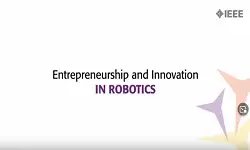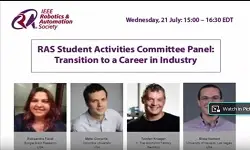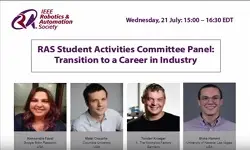-
Members: FreeRAS
IEEE Members: Free
Non-members: FreeLength: 00:37:01
29 May 2017
Video Description
In this talk, I give an overview of our research on motion optimization for humanoid and wearable robots. On the one hand, we are interested to improve the walking capabilities of humanoid robots in different terrains. Optimization based on realistic mechanical models of the robots is a very helpful tool since it can generate motions for such redundant, underactuated systems with multiple degrees of freedom and changing contacts that are feasible, stable and optimal. Optimization can also be applied to compliant robots.
On the other hand, we are interested to improve the design and control of wearable robots for the lower limbs and the lower back and other assistive devices. Using combined models of humans and the devices and optimal control, we can predict human movement in different conditions and determine the best possible support actions selecting passive and active components.
One important approach for both research fields is the solution of inverse optimal control problems based on recorded motion data which allows to identify objective functions underlying human movement. These optimality criteria can then be transferred to humanoid robots or be used for human movement prediction. For both fields, I will discuss the modeling levels to be used for describing humans and robots to address specific research questions. In addition, I will discuss possible combinations of optimal control methods with reinforcement learning and movement primitive approaches to reduce computation times and improve robot control.
ICRA 2017
The 2017 IEEE International Conference on Robotics and Automation (ICRA) was held from May 29 to June 3, 2017 at Sands Expo and Convention Centre, Marina Bay Sands in Singapore. ICRA is IEEE Robotics and Automation Society's flagship conference and is a premier international forum for robotics researchers to present their work. The conference theme, “Innovation, Entrepreneurship, and Real-world Solutions”, underscores the need for innovative R&D talent, dynamic and goal-driven entrepreneurs and practitioners using robotics and automation technology to solve challenging real-world problems such as shortage of labour, an ageing society, and creating sustainable environments.
Speaker
Katja Mombaur is a full professor at the Institute of Computer Engineering (ZITI) of Heidelberg University and head of the Optimization in Robotics & Biomechanics (ORB) group as well as the Robotics Lab. She holds a diploma degree in Aerospace Engineering from the University of Stuttgart and a Ph.D. degree in Mathematics from Heidelberg University. She was a postdoctoral researcher in the Robotics Lab at Seoul National University, South Korea. She also spent two years as a visiting researcher in the Robotics department of LAAS-CNRS in Toulouse.
Katja is the coordinator of the newly founded Heidelberg Center for Motion Research. She also is PI in the European H2020 project SPEXOR and the Graduate School HGS MathComp as well as in several national projects. Until recently, she has coordinated the EU FP7 project KoroiBot and was PI in the EU projects MOBOT and ECHORD–GOP. She is founding chair of the IEEE RAS technical committee Model-based optimization for robotics.
In this talk, I give an overview of our research on motion optimization for humanoid and wearable robots. On the one hand, we are interested to improve the walking capabilities of humanoid robots in different terrains. Optimization based on realistic mechanical models of the robots is a very helpful tool since it can generate motions for such redundant, underactuated systems with multiple degrees of freedom and changing contacts that are feasible, stable and optimal. Optimization can also be applied to compliant robots.
On the other hand, we are interested to improve the design and control of wearable robots for the lower limbs and the lower back and other assistive devices. Using combined models of humans and the devices and optimal control, we can predict human movement in different conditions and determine the best possible support actions selecting passive and active components.
One important approach for both research fields is the solution of inverse optimal control problems based on recorded motion data which allows to identify objective functions underlying human movement. These optimality criteria can then be transferred to humanoid robots or be used for human movement prediction. For both fields, I will discuss the modeling levels to be used for describing humans and robots to address specific research questions. In addition, I will discuss possible combinations of optimal control methods with reinforcement learning and movement primitive approaches to reduce computation times and improve robot control.
ICRA 2017
The 2017 IEEE International Conference on Robotics and Automation (ICRA) was held from May 29 to June 3, 2017 at Sands Expo and Convention Centre, Marina Bay Sands in Singapore. ICRA is IEEE Robotics and Automation Society's flagship conference and is a premier international forum for robotics researchers to present their work. The conference theme, “Innovation, Entrepreneurship, and Real-world Solutions”, underscores the need for innovative R&D talent, dynamic and goal-driven entrepreneurs and practitioners using robotics and automation technology to solve challenging real-world problems such as shortage of labour, an ageing society, and creating sustainable environments.
Speaker
Katja Mombaur is a full professor at the Institute of Computer Engineering (ZITI) of Heidelberg University and head of the Optimization in Robotics & Biomechanics (ORB) group as well as the Robotics Lab. She holds a diploma degree in Aerospace Engineering from the University of Stuttgart and a Ph.D. degree in Mathematics from Heidelberg University. She was a postdoctoral researcher in the Robotics Lab at Seoul National University, South Korea. She also spent two years as a visiting researcher in the Robotics department of LAAS-CNRS in Toulouse.
Katja is the coordinator of the newly founded Heidelberg Center for Motion Research. She also is PI in the European H2020 project SPEXOR and the Graduate School HGS MathComp as well as in several national projects. Until recently, she has coordinated the EU FP7 project KoroiBot and was PI in the EU projects MOBOT and ECHORD–GOP. She is founding chair of the IEEE RAS technical committee Model-based optimization for robotics.


